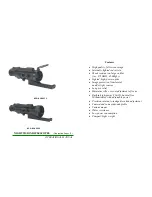
screwdriver (See Figure 15). Turning the screw clockwise will
move the secondary mirror toward the front opening of the
optical tube, while turning the screw counter-clockwise will
move the secondary mirror toward the primary mirror.
Note: When making these adjustments, be careful not to
stress the spider vanes or they may bend.
When the secondary mirror is centered in the focuser draw-
tube, rotate the secondary mirror holder until the reflection of
the primary mirror is as centered in the secondary mirror as
possible. It may not be perfectly centered, but that is OK. Now
tighten the three small alignment screws equally to secure the
secondary mirror in that position. This adjustment will rarely, if
ever need to be done.
If the entire primary mirror reflection is not visible in the sec-
ondary mirror, as in Figure 14c; you will need to adjust the tilt
of the secondary mirror. This is done by alternately loosening
one of the three alignment set screws while tightening the
other two, as depicted in Figure 16. The goal is to center the
primary mirror reflection in the secondary mirror, as in Figure
14d. Don’t worry that the reflection of the secondary mirror
(the smallest circle, with the collimation cap “dot” in the cen-
ter) is off-center. You will fix that in the next step.
Adjusting the Primary Mirror
The final adjustment is made to the primary mirror. It will need
adjustment if, as in Figure 14d, the secondary mirror is cen-
tered under the focuser and the reflection of the primary mir-
ror is centered in the secondary mirror, but the small reflec-
tion of the secondary mirror (with the “dot” of the collimation
cap) is off-center.
The tilt of the primary mirror is adjusted with three spring-
loaded collimation thumbscrews on the back end of the opti-
cal tube (bottom of the primary mirror cell); these are the larg-
er thumbscrews. The other three smaller thumbscrews lock
the mirror’s position in place; these thumbscrews must be
loosened before any collimation adjustments can be made to
the primary mirror.
To start, turn the smaller thumbscrews that lock the primary
mirror in place a few turns each. (Figure 17) Use a screwdriv-
er in the slots, if necessary.
Now, try tightening or loosening one of the larger collimation
thumbscrews with your fingers (Figure 18). Look into the
focuser and see if the secondary mirror reflection has moved
closer to the center of the primary. You can tell this easily with
the collimation cap and mirror center mark by simply watch-
ing to see if the “dot” of the collimation cap is moving closer
or further away from the “ring” on the center of the primary
mirror mark. When you have the dot centered as much as is
possible in the ring, your primary mirror is collimated. The
view through the collimation cap should resemble Figure 15e.
Re-tighten the locking thumbscrews.
A simple star test will tell you whether the optics are accu-
rately collimated.
Star-Testing the Telescope
When it is dark, point the telescope at a bright star and accu-
rately center it in the eyepiece’s field-of-view. Slowly defocus
the image with the focusing knob. If the telescope is correctly
13
Figure 17.
The three thumb screws that lock the primary mirror in
place must first be loosened before any adjustments can be made.
Figure 18.
The tilt of the primary mirror is adjusted by turning
one or more of the three spring-loaded collimation thumb screws.
Figure 15.
To center the secondary mirror under the focuser,
hold the secondary mirror holder in place with your fingers while
adjusting the center screw with a Phillips screwdriver. Do not touch
the mirror’s surface!
Figure 16.
Adjust the tilt of the secondary mirror by loosening or
tightening the three alignment screws with a 2mm Allen wrench.
15.
16.




























